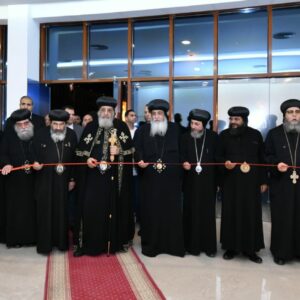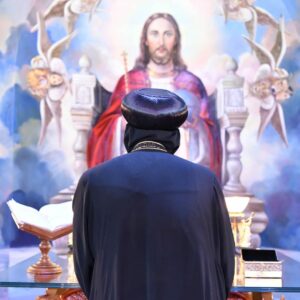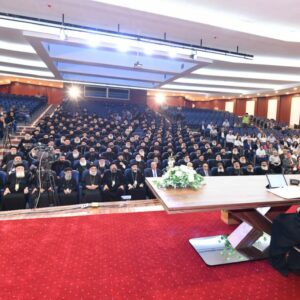His Holiness Pope Tawadros II delivered his weekly sermon at the Wednesday meeting this evening, which was held as part of the second seminar for the fathers and priests of the dioceses of the Canal and Red Sea governorates and a number of the dioceses of Lower Egypt and Upper Egypt, at the lodging house for visitors of the Monastery of Saint Paul in the Red Sea, which began on November 5th, within the framework of the pastoral concern and internal management of the priests. The sermon was broadcast on Christian satellite channels and the C.O.C channel affiliated with the Church’s Media Centre on the Internet.
Before the start of the sermon, H.H. inaugurated the new theatre at St. Paul’s residence, commending its distinguished equipment, which was completed in just two months.
In his speech, His Holiness addressed the work of the priest and the dimensions of his relationships, and pointed to the common signs that priests are supposed to have, which are:
1- Healthy witnesses: They must enjoy spiritual health as a living model before the flock, and there should be no gap between words and deeds, and the priest must create a spiritual climate within his church, “On earth as it is in heaven.” (Matthew 6:10), and he is in constant communication with people and has a spiritual touch with everyone.
2- Strong teachers: He must be a strong teacher in virtue, doctrine, history, and the present, and he must have a clear vision for renewing the mind and the teachings and lessons he presents, and he must know the social composition of the people.
3- A great loving person: He must have the energy of love, because love is our capital, and he must offer God’s love to everyone with an open heart and a pure soul. The closer he gets to God, the more tender and merciful his heart will be.
As His Holiness explained, “What is the work of a priest?” As follows:
1- Visitor: He constantly visits like a father, as fatherhood is the peak of care.
2- He teaches: He is a strong teacher, and presents his readings and knowledge to the people in a way that suits them according to their age and culture.
3- Confessor: He takes confessions from the congregation, because confession is a form of spiritual medicine that comforts souls, and this is the most difficult work he does.
4- Constructor: He is active and works on projects that serve the community and the church, because the church has two roles: a spiritual, salvation role and a social role to serve the community in every way.
5- Prayer: He praises and sings from the heart in the language of the people, and he is responsible for explaining prayers, hymns, and so on to the people.
6- Courteous: to be a heartfelt participant in various situations, “Rejoice with those who rejoice, and weep with those who weep.” (Romans 12:15)
7- A role model: He is a model and example for the congregation as a permanent member in every home
His Holiness addressed seven dimensions of priest relationships, which are:
1- His relationship with himself: It requires frankness, self-examination, and constant review, lest any stumbling happens, causing him to change his behaviour.
2- His relationship with his family: It requires taking care of his wife and children, who need the happiness of being present, by providing them with quality time.
3- His relationship with other priests: It requires decency, dealing with the dignity of the priesthood, offering cooperation and brotherly affection, keeping secrets, and doing what is appropriate with everyone
4- His relationship with his bishop: It requires complete honesty, and that he be honest in providing information, and in admitting mistakes, and that he has honesty in discipline (the law), and in financial matters in general regarding the service. “Be faithful until death, and I will give you the crown of life.” (Revelation 2:10)
5- His relationship with the people: It requires fatherhood, because God sent him with the responsibility of a father who loves, forgives, encourages, and is patient, and to act wisely, and the relationship contains spiritual, cognitive, and physical satisfaction, as well as an abundance of love
6- His relationship with his church: It requires witnessing the truth, teaching the church’s teachings, following upright behaviour in preserving and presenting the doctrine, and paying attention to the heritage of Coptic melodies and language, because our Egyptian church is one of the oldest churches in the world.
7- His relationship with Christ: It requires personal knowledge and worship in the spirit, because worship in the spirit is the foundation, and that he live by the Gospel, which St. Chrysostom called “a mine of pearls,” and that he explain worship to his people in a vivid way through prayers for them.
This page is also available in:
العربية





















